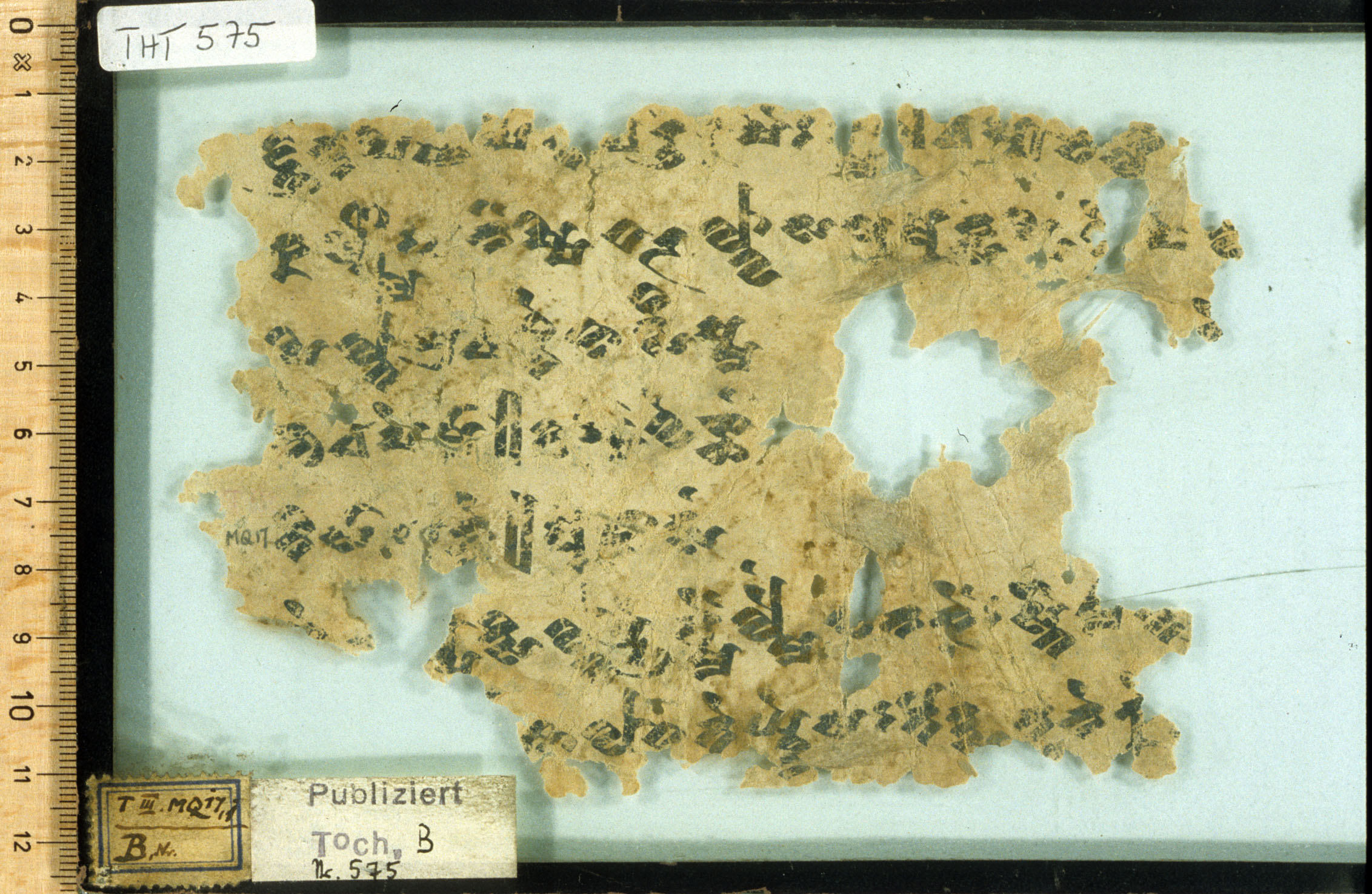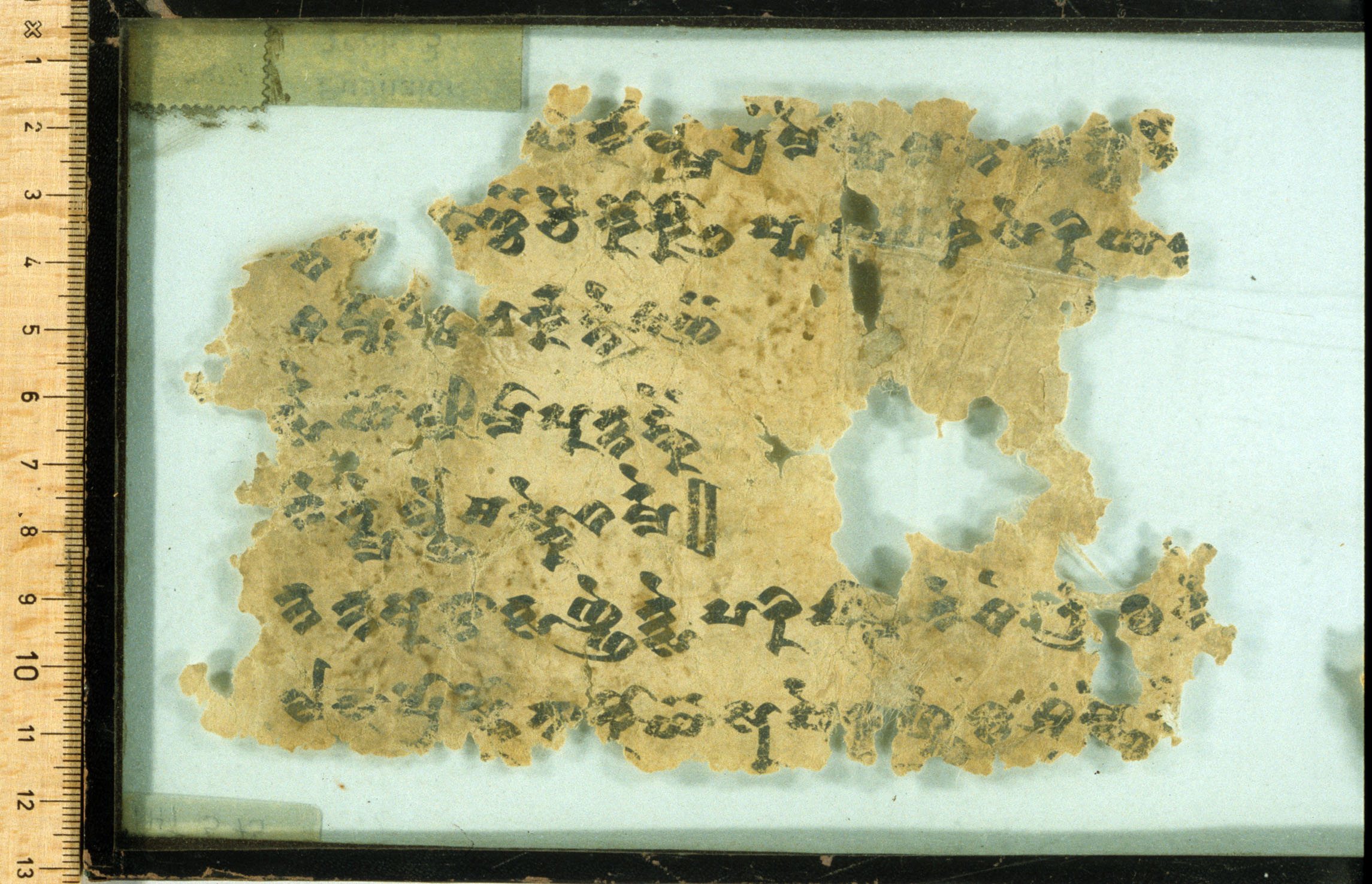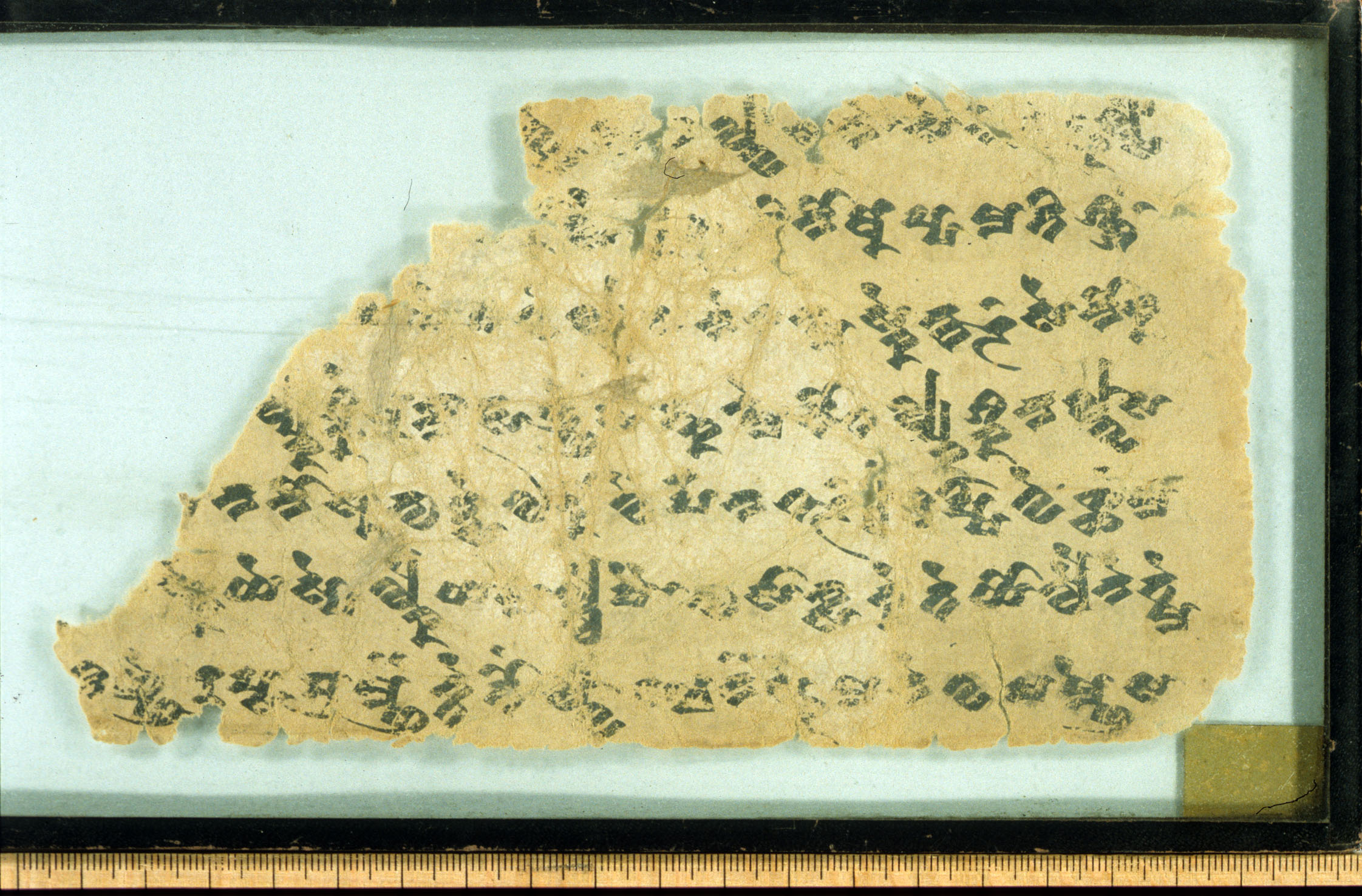THT 575
| Known as: | THT 575; B 575; Bleistiftnummer 2558 |
|---|---|
| Cite this page as: | Adrian Musitz (translation). "THT 575". In A Comprehensive Edition of Tocharian Manuscripts (CEToM). Created and maintained by Melanie Malzahn, Martin Braun, Hannes A. Fellner, and Bernhard Koller. https://cetom.univie.ac.at/?m-tht575 (accessed 05 Jul. 2025). |
Edition | |
| Editor: | Adrian Musitz (translation) |
Provenience | |
| Main find spot: | Kizil Ming-öy |
| Expedition code: | T III MQ 17.1 |
| Collection: | Berlin Turfan Collection |
Language and Script | |
| Language: | TB |
| Linguistic stage: | classical |
| Script: | classical |
Text contents | |
| Title of the work: | Teacher-pupil dialogue about doctrinal stories |
| Passage: | Bodhisattva as lion instructing animals |
| Text genre: | Literary |
| Text subgenre: | Doctrine |
| Verse/Prose: | prose; verse |
| Meter: | 43434 (4x) |
Object | |
| Manuscript: | THT 574-576 |
| Preceding fragment: | THT 574 |
| Material: | ink on paper |
| Form: | Poṭhī |
| Size (h × w): | 10.2 × 15+17 cm |
| Number of lines: | 7 |
Images
Images from idp.bl.uk by courtesy of the International Dunhuang Project, the Berlin-Brandenburgische Akademie der Wissenschaften, and the Staatsbibliothek zu Berlin – Orientabteilung.
Transliteration
(continues from THT 574)
| a1 | jñ· nta pi¯ ¯ś p[o] [nt]· – ru [r]· ṣai : ·m· l· e py·[¯] [¯c] kl· /// /// ñ[ä] kcy[a] [k]l· tso : 1 pa ra ci tta jñāṃ e ru ra [ddh]i – – tu ra n· ṣ[ai] cwy· |
|---|---|
| a2 | ka lymi : [e] nä ṣṣi ta¯ ¯r lwā sa su a ksa [ṣṣ]i [m]e pe [l]· /// /// [lau] ṣai a pra ma ṇi nta cä ñcro na a n[tp]i śka rtse¯ ¯ś [t]s· nu ppā lṣi |
| a3 | pi ltā ṣra e śne au rtsi ṣma ·e /// /// yä kne sa lwā [sā]ṃ¯ ¯ts pe lai kne a ksa ṣ[ṣ]i ka rsa no yeṃ to¯ ¯yä |
| a4 | tu e pe mā || ka ṣṣī we s̝s̝aṃ /// /// na ·o – – [o] mp[o] [staṃ] su ceṃ[¯] [¯]t[s] pe lai kne a ksa ṣṣi || ra |
| a5 | ti sā ya kne || a [kn]ā tsaṃ /// /// r[w]a – pa lsko [sa] – tstso – [n]e [c]m· la ne : ke te ā |
| a6 | ·e – [l]pā tsi lwā ññe cmeṃ lmeṃ [ai] na keṃ : snai m[ā] nt· /// /// ·e¯ – ta ryā [y]ä kne [t]tā so : śa kyä kne sa yo |
| a7 | – – – – śā lā ta te ykne sa : to ntsa t[a] ne ke /// /// yā mo rnta pa t[ta] s[a]¯ ¯t : 2 || – me w[a] |
| b1 | – – – (–) o no lm[i] tr[e] me ṣṣi ma nta l· cci ·ai /// /// wse (– –) lw· ·(·)ne • se n· ·[ṅka] ls[o] |
| b2 | ·ta – ·[s]·¯ ¯ñcä cai ko kī¯ ¯l ṣpa r[ā] yä kre se ri ya m· /// /// [ro] tse – – ·i no a ppa ma ti śśa • |
| b3 | śa mp[o] ṣṣi e rka tte śa[¯] [¯]ñä /// /// ·e ś· [w]· l[w]ā sa ne [ta] nma ske nta¯ ¯r : se no ka |
| b4 | rtse yo lo mā pu tta ṅkeṃ /// /// lyka [ś]ke a knā tsa ññe [tsa] ṅka nme to¯ ¯t lyka śka na lwā sa |
| b5 | ne cme lñe ma ske ta rme || /// /// na no su tu ntse o k[o] wä rpa na ta¯ ¯r || ka ṣṣī we s̝s̝aṃ ma |
| b6 | nta nta a knā tsa ññe ntse pa ri hā¯ ¯r ne saṃ [•] kru[i] tu ne /// /// [s]ke ye spe lke ya ma lle ṣai • tu sā ksa ke te yo lai ne cme |
| b7 | la sa pro sko ta ko¯ ¯yä su ṣe ka ññe [ai] śa mñe [ne] /// /// [ka] ññe ru psa bra mñä kte toṃ lwā sa e nä sk[e] ma ne wa ṣa mñe sa |
Transcription
(continues from THT 574)
| 1c | jñ(ä)nta piś pont(a) (e)ru r(a) ṣai : |
|---|---|
| 1d | (c)m(e)l(a) epy(a) c kl· /// /// ; ñäkcya kl(au)tso : 1 |
| Xx | paracittajñāṃ eru ; räddhi – – tu ran(o) ; ṣai cwy (e) a2 kalymi : |
| Xx | enäṣṣitär lwāsa su ; aksaṣṣime pel· /// /// lau ṣai apramaṇinta cäñcrona antpiś kartseś ts(e)n uppālṣi a3 piltāṣ ra eśne aurtsi ṣma(r)e /// /// yäknesa lwāsāṃts pelaikne aksaṣṣi kärsanoyeṃ toy a4 tu epe mā ॥ käṣṣī weṣṣäṃ /// /// na ·o – – ompostäṃ su ceṃts pelaikne aksaṣṣi ॥ ra a5 tisāyakne ॥ aknātsaṃ /// /// rwa ; – palskosa – tstso (ta) ; ne cm(e)lane : |
| 2d | kete ā a6 (ñm)e (tsä) lpātsi ; lwāññe cmeṃlmeṃ ainakeṃ : snai mānt· /// /// ·e – täryā yäkne (pri)ttāso : śak yäknesa yo a7 – – – – śālāt{†ä} te-yknesa : tontsa tane ke /// /// yāmornta pättasat : 2 |
| Xx | ॥ – me wa b1 – – – – onolmi tremeṣṣi mantal(ai)cci (c)ai /// /// wse – – lw· (s)·ne • se n· (e)ṅkalso b2 ·tä – ·s· ñc cai kokīl ṣparā yäkre seri yam· /// /// rotse – – ·i no appamatiśśa • b3 śampoṣṣi erkatteśañ /// /// ·eś· w· lwāsane ; tänmaskentär : |
| Xx | se no ka b4 rtse yolo mā ; puttaṅkeṃ /// /// lykaśke aknātsaññe tsaṅkanme tot lykaśkana lwāsa b5 ne cmelñe mäsketär-me ॥ /// /// ; nano su tuntse oko ; wärpanatär ॥ |
| * | käṣṣī weṣṣäṃ ma |
|---|---|
| b6 | ntanta aknātsaññentse parihār nesäṃ • krui tu ne /// /// skeye spelke yamalle ṣai • tusāksa kete yolaine cme |
| b7 | lasa prosko takoy su ṣekaññe aiśamñene /// /// käññe rupsa bram-ñäkte toṃ lwāsa enäskemane waṣamñesa |
Translation
(continues from THT 574)
| a1 | ... he had evoked all five (abhi)jñas. ... remember the births... divine ear. He (had) evoked telepathy, magical power... |
|---|---|
| a1+ | This was also in his power. |
| a2 | He would instruct animals. He would tell them the law. ... was far. |
| a2+ | Lovely apramaṇinta(?) for both, for good, wide eyes like petals of a blue lotus, smooth/oil... |
| a3 | ... he would proclaim the law in (this) way to the animals. |
| a3+ | Would they understand it or not? |
| a4 | The teacher says... ... afterwards he wold proclaim the law to them. |
| a4+ | In the *ratisāyak-tune: |
| a5 | Ignorant... ... with the mind here... in births... |
| a5+ | Whoever has the wish to be liberated from mean animal birth, without malice... seek in three ways! |
| a6+ | Ten ways... bring...! |
| a7 | Through them here... ... put the deeds...! |
| a7+ | ... the angry, malicious beings... |
| b1+ | ... (among animals) ... cuckoo, sparrow hawk, seri, goose... |
| b2+ | ... (they are) scornful, proud, hostile... |
| b3 | ... they are born among animals. |
| b3+ | Those who don't distinguish between good and evil, ... (how) fine an ignorance arises to them, their birth is among the so fine (=small?) animals. |
| b5 | ... he in turn enjoys the fruit of that. The teacher says: |
| b5+ | Never is there guarding from ignorance. |
| b6 | If there..., zeal and effort would be made. |
| b6+ | Thus, whoever would have fear of births in evil, he... always in wisdom... |
| b7 | Brahma in the form of..., instructing the animals, through friendship... |
Other
| a2 | Er unterwies die Tiere [und] trug ihnen das Gesetz vor. (Schmidt 1974: 509) |
|---|
References
Online access
Edition
Sieg and Siegling 1953: 361-363
Translations
Carling 2000: a5 (403); Hackstein 1995: a1 (47); Krause 1952: b6 (55); Schmidt 1974: a2 (509); Thomas 1952: b5 (58), b6 (46); Thomas 1957: a1 (305), a2 (306), a3 (82), a3 a4 (82); Thomas 1970: a2 a3 (260); Thomas 1986: b5 (122)
Bibliography
Carling, Gerd. 2000. Die Funktion der lokalen Kasus im Tocharischen. Berlin/New York: de Gruyter.
Hackstein, Olav. 1995. Untersuchungen zu den sigmatischen Präsensstammbildungen des Tocharischen. HS Erg.-Heft 38. Göttingen: Vandenhoeck & Ruprecht.
“The International Dunhuang Project: The Silk Road Online.” n.d. http://idp.bl.uk.
Krause, Wolfgang. 1952. Westtocharische Grammatik, Band I. Das Verbum. Heidelberg: Winter.
Schmidt, Klaus T. 1974. “Die Gebrauchsweisen des Mediums im Tocharischen.” PhD, Universität Göttingen.
Sieg, Emil, and Wilhelm Siegling. 1953. Tocharische Sprachreste. Sprache B, Heft 2. Fragmente Nr. 71-633. Edited by Werner Thomas. Göttingen: Vandenhoeck & Ruprecht.
Thomas, Werner. 1952. Die tocharischen Verbaladjektive auf -l. Deutsche Akad. der Wissenschaften zu Berlin, Institut für Orientforschung 9. Berlin: Akademie-Verlag.
Thomas, Werner. 1957. Der Gebrauch der Vergangenheitstempora im Tocharischen. Wiesbaden: Harrassowitz.
Thomas, Werner. 1970. “Zu einer stilistischen Besonderheit im Tocharischen.” Zeitschrift für Vergleichende Sprachforschung 84: 254–80.
Thomas, Werner. 1986. “Zur Stellung von toch. A nuṃ, B nano ‘wieder’ innerhalb des Satzes.” Zeitschrift für Vergleichende Sprachforschung 99: 117–46.
Gippert, Jost, Katharina Kupfer, Christiane Schaefer, and Tatsushi Tamai. n.d. “Thesaurus Indogermanischer Text- und Sprachmaterialien (TITUS): Tocharian Manuscripts from the Berlin Turfan Collection.” http://titus.fkidg1.uni-frankfurt.de/texte/tocharic/thtframe.htm.






